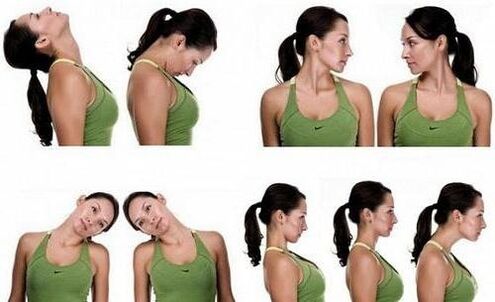Osteochondrosis of the cervical spine (CS) is one of the most common pathologies of the musculoskeletal system. Every year, doctors diagnose the disease more often, and the disease is getting worse. According to statistics, in women, degenerative-dystrophic changes in the upper spine are more frequent, especially for patients in the postmenopausal period. The main symptoms of cervical osteochondrosis in women are pain, limited movement, lack of cerebral circulation, and this is dangerous not only for health, but also for life. To protect yourself from the consequences of dangerous pathology, you need to start treating it at an early stage. It is important to carry out complex therapies, lifestyle changes to stop the destruction of spinal segments and prevent serious complications.
Disease progression
The cervical spine is the most susceptible to a variety of injuries and degenerative changes. This is due to the fact that this segment is the easiest to move, and its muscles are weak here. The small cervical vertebrae withstand heavy daily stress, leading to the gradual destruction of the intervertebral disc. The vertebrae press against each other, which is why the cartilage lining between them loses a lot of fluid, begins to deteriorate and change shape.
In addition, osteochondrosis of the cervical spine develops due to inadequate nutrition of cartilage tissue. And the spinal canal in this area is narrow, therefore often pinched, which causes neurological symptoms.
Pathology in women at an early stage is indicated by a feeling of heaviness in the back of the head, tingling in the hands, and so on. Often, patients confuse the first sign of the disease with overwork.
A large number of blood vessels and nerve roots are located in the neck area, and when they are compressed, neurological disorders can also occur. It is especially dangerous if a deformed disc or vertebra compresses the vertebral arteries, which feed an important part of the brain. When squeezed, movement coordination is disrupted, a woman can lose balance, her vision and hearing deteriorate, and her risk of stroke increases.
References. According to statistics, cervical osteochondrosis is most often found in patients aged 25-40 years. This is due to a significant decrease in physical activity, inactive work. Women are more likely to be diagnosed with the disease than men, as they have more fragile spines and thinner bone tissue.
Doctors distinguish 4 stages of osteochondrosis:
- Stage 1 - the intervertebral disc loses moisture, its height decreases, cracks may appear on the fibrous ring (outer shell). This is a stage of cervical chondrosis, which is difficult to identify, as it has unexplained symptoms. The neck is quickly tired, there is discomfort, heaviness in the damaged area, sometimes there is a slight pain that quickly passes.
- Level 2 - cracks on the surface of the disc increase, the nucleus pulposus (gel -like content on the disc) is displaced, able to protrude through the damaged area. This is how the protrusion of the cartilage layer appears, which can compress the spinal cord and its roots. Periodically, there is severe pain, weakness, limited movement, numbness of the face, neck, shoulders, arms.
- Stage 3 - the protrusion penetrates the outer shell of the disc, resulting in a hernia. The pain becomes more pronounced, there are neurological disorders.
- Level 4 - the disc is almost completely destroyed, the vertebrae rub against each other, bone growths (osteophytes) appear on its edges, which are designed to stabilize the damaged segment. Nerve endings, spinal cord, blood vessels are disturbed. Adjacent joints begin to break down. Clinical signs are pronounced.
Easiest to stop degenerative-dystrophic changes in the first two stages of osteochondrosis SHOP. At stage 3, complex treatment will help stop the destruction of more distant spinal segments. In the last stage, you cannot do without surgery.
The reasons
SHOP osteochondrosis is a complex and lengthy process that often has several causes. In most cases, the pathology occurs as a result of an inactive lifestyle, malnutrition, metabolic disorders. Often, the disease occurs due to injury or due to the natural aging of the body and the weakness of its defenses.
Doctors identify the main causes of SHOP osteochondrosis in women:
- Disorders of metabolic processes.
- Passive lifestyle.
- Genetic predisposition.
- Chronic muscle tension around the cervical segment.
- Postural curvature.
- Lack of fluids and nutrients in the body.
- Prolonged stay in an uncomfortable position (neck tossed forward and back hooked).
- Overweight.
- Often wear high -heeled shoes.
- STORE injuries.
- Lifting heavy objects.
- Autoimmune pathology.
- Frequent stress, chronic fatigue.
- Hypothermia.
- Contagious disease.
- The neck is too long or too short, and so on.
All of these factors contribute to the malnutrition of the intervertebral disc and lead to its deterioration.
Female cervical osteochondrosis can be caused by pathology of the vertebral arteries associated with genetic predisposition, intrauterine disorders, trauma during childbirth. The disease can occur as a result of rheumatic diseases, endocrine disorders, excessive load on the cervical segment during pregnancy, local load.
Important. The leading cause of cervical osteochondrosis in women is menopause, as well as changes associated with this period. At this stage, the concentration of progesterone, which is very important for bone tissue, decreases in the body. The possibility of degenerative changes is associated with age -related neck muscle weakness and spinal support weakness in this area.
Symptoms
For osteochondrosis, a wave -like course is characteristic, when the acute period is replaced by remission. Miscarriage can cause infection, injury, hypothermia, prolonged pressure on the neck.

The first signs of cervical osteochondrosis in women are headache, discomfort, heaviness in the neck. It is important to distinguish in time chondrosis pain from migraine or autonomic dysfunction.
Clinical manifestations of KEDAI osteochondrosis in women due to neurological syndrome:
- Cervical dyscalgia occurs when nerve endings are disrupted by fragments of the damaged cartilage layer. Then there is a certain cramping in the neck, pain, which becomes more pronounced when moving the head and after sleep.
- Scalene muscle syndrome results from damage to the ducts and nerves of the brachial plexus and subclavian arteries. This symptom complex is accompanied by pain from the inner surface of the shoulder to the hand from the injured part. Limbs become pale, cold, edematous, numbness occurs. Neck pain extends to the back of the head as the patient turns his head.
- Shoulder -scapular periarthrosis syndrome - dystrophic changes affecting the tendon fibers that surround the shoulder. The painful sensation from the neck radiates to the shoulder girdle and shoulders. There is a forced neck position - it is inclined to the affected side, and the shoulders are slightly lowered.
- Vertebral artery syndrome - blood vessels are compressed by fragments of damaged discs or osteophytes (depending on the stage of the disease). Patients dizziness and headache, nausea, sometimes vomiting. The pain is localized in the occiput, crown and temples.
- Heart - the nerve endings of the spinal cord are damaged. There is heart disease, arrhythmias. If C3 is damaged, pain appears in half of the neck, the tongue is swollen, the patient is unable to chew food normally. If C4 is injured, then discomfort appears in the area of the shoulder girdle, collarbone, heart. With the defeat of C5, the pain reaction from the neck extends to the shoulder girdle, the inner surface of the shoulder. C6 irritation manifests itself as pain from the neck and scapula to the shoulder girdle and spreads throughout the arm to the thumb. If the C7 is damaged, the pain syndrome spreads to the back of the shoulder girdle, capturing the entire hand, including the index and middle fingers. As C8 is squeezed, the pain spreads from the affected area to the elbow and little finger.
Also, a woman's emotional field may be disturbed, weaknesses appear, she becomes anxious, sensitive. Insomnia often occurs, memory and attention become impaired due to frequent headaches.
Symptoms of a cerebrovascular accident appear when a woman suddenly turns her head backwards, tilts it, or does work that puts a load on the arms and cervical spine, for example, when she digs, paints the ceiling, and carries loads.
Violations of cerebral circulation are indicated by dizziness, shaky gait, "flies" in front of the eyes, tinnitus, weakness, nausea. In some patients, the voice becomes hoarse, sometimes disappearing, a sore throat appears.
Osteochondrosis during menopause is accompanied by migraines, increased body sweating in the area between the neck and shoulder girdle. When the vertebral arteries are compressed, the work of the cardiovascular system is disrupted.
If the disease lasts a long time, then there is a circulatory failure of important centers that carry out neuro-endocrine functions. Due to the increased permeability of the vascular wall, atherosclerosis of the cerebral arteries and heart develops.

Establish a diagnosis
If you notice symptoms of osteochondrosis, go to a therapist. After a visual examination, the specialist will refer you to an orthopedist, vertebrologist, or neurologist.
To diagnose cervical osteochondrosis, the following methods are used:
- X-rays allow you to know that the patient has moved the vertebrae, osteophytes are present at its edges, the distance between the vertebrae has decreased. For this, the study was conducted in different fields. To detail the characteristic changes, the doctor took a picture of the vision.
- CT of the cervical spine provides detailed information on pathological changes in the vertebrae. This method allows you to obtain volumetric images for a more detailed study, this method is used in severe diagnostic cases.
- MRI is used to accurately assess the condition of soft tissues (nerves, blood vessels, ligaments, muscles) in the affected area.
- Electromyography allows you to examine the conduction of nerve fibers.
Also, the doctor may prescribe a Doppler ultrasound (Doppler ultrasound of the great cerebral arteries) to determine the state of blood flow in this area.
Conservative treatment
In the early stages, treatment of STORE osteochondrosis in women can be carried out at home. However, physicians should devise a therapeutic regimen. It is important to understand that this is a long process and it is unlikely that it will heal completely (especially for older women).
Complex treatments include:
- Taking medicine.
- Use of orthopedic devices.
- Physiotherapy.
- Physiotherapy procedures.
- Massage, manual effects.
- Alternative treatments.
Conservative techniques will help stop pain, inflammation, normalize muscle tone, improve metabolic processes, nutrition of damaged spinal segments. With timely therapy, it is possible to stop the pathological changes.

Medication for cervical osteochondrosis will help relieve inflammation and pain.
Treatment of cervical osteochondrosis in women is carried out with the use of drugs that will help increase the metabolism of the cartilage layer between the vertebrae, stop inflammation, pain. For this purpose, the following drugs are used:
- NSAIDs. May help relieve mild to moderate inflammation and pain.
- Analgesic. Pain relieved.
- Preparations to improve cerebral circulation.
- Muscle relaxation helps relieve muscle cramps.
- Chondroprotectors. They help stop disc destruction, improve metabolic processes, and speed recovery.
- Magnesium -based medicine.
- Nootropic. They stimulate the work of the brain by normalizing its blood circulation, have a mild sedative effect.
References. With intense pain that cannot be overcome with oral medications, therapeutic blockers are used, for example, with Novocaine or NSAID solutions.
Treatment can be supplemented with anti-inflammatory and painkillers in the form of gels, creams and ointments. They will be effective at the remission stage or in conjunction with oral agents.
The decision on the choice of drug combination is made by the doctor. The specialist will compile a regimen for taking the medication, as well as determine its dosage. It is important to follow its recommendations, as many of the above drugs threaten dangerous complications.
During the acute stage of STORE osteochondrosis, a woman must give up strenuous physical activity. To release the cervical segment, you need to wear a special corset (Shants collar), which will fix the spine in the correct position. This device is recommended for use during non -settled or hard physical work.
Physiotherapy procedures will help reduce pain and improve blood circulation in the damaged area:
- Diadynamic therapy.
- Magnetotherapy.
- Electrophoresis.
- Electroanalgesia.
- Ultraviolet irradiation and so on.
The effect of therapy is shown after about the third session, then headache, hearing loss, visual disturbances, dizziness, normal or lost sleep, and general condition improves.
With the help of submarine traction of the cervical segment, it is possible to widen the distance between the vertebrae, release nerves or blood vessels from compression, and restore the normal position of the vertebrae.
Massage will normalize muscle tone, reducing the flow of lymph fluid, which causes swelling. After a few sessions, blood circulation in the damaged area improves.

Therapeutic gymnastics is one of the most effective methods of treating osteochondrosis SHOP. Exercise therapy allows you to strengthen weak neck muscles, which will then take some of the load off the spine and help stop or slow down degenerative-dystrophic changes. During class, blood circulation is improved, metabolic processes, disc nutrition is accelerated, which has a positive effect on his condition.
Women have to practice every day. They consist of simple but effective exercises. The complex consists of the circumference, the inclination of the head in different directions, as well as the movement of the neck, in which the hands are used. These elements can be done at home, but only with a doctor's permission. Physiotherapy training is carried out only at the stage of remission.
Complex treatments can be supplemented with reflexology (acupuncture), hirudotherapy (leech therapy), swimming, and so on.
Surgery
Surgery is prescribed in the last stage of SHOP osteochondrosis, which is accompanied by serious destruction of osteochondral structures. Also, surgical intervention is essential if conservative techniques are ineffective or the spinal canal is significantly narrowed.
In the cases described above, anterior cervical dysectomy is performed. During the procedure, the doctor paralyzes the damaged spinal segment and removes the hernia that presses on the spinal nerve. Then the vertebrae, where the disc is removed, fuse. If necessary, the space between the vertebrae is filled with synthetic inserts (cages).
After 3-5 days, the patient leaves the house. The recovery period is about 12 weeks. To speed recovery, you need to take medication, wear a corset, lead a healthy lifestyle, go to physiotherapy procedures, and finally do therapy.
Lifestyle suggestions
To quickly eliminate the unpleasant symptoms of osteochondrosis and stop the degenerative-dystrophic changes in the cervical segment, you need to adjust your lifestyle. To do this, patients must follow the following recommendations:
- Take a walk every day, avoid running, jumping and other explosive activities.
- Heavy objects cannot be carried.
- You can not sit for long, in extreme conditions, wear a corset and periodically take a horizontal position.
- Perform specific physical exercises for the back muscles at home.
- Sleep on orthopedic mattresses and special pillows.
- Follow a diet, supplement foods with foods rich in magnesium, calcium (nuts, dairy products, seafood, legumes), as well as plant fiber, chondroitin (meat jelly, jelly). Reject fatty, fried, overly salty, alcoholic foods. The doctor will tell you about the dietary rules in more detail. But in any case, it must be right.
Hypothermia should not be tolerated, warming will be beneficial in the absence of inflammatory processes.
Complications
If there is no timely treatment of cervical osteochondrosis, a woman may experience the following pathological consequences:
- Possible protrusion, which after some time turns into a hernia. The bulge presses on his spinal cord and nerves, causing neurological damage.
- Osteophytes appear when the disc is severely damaged; they interfere with spinal nerves and blood vessels.
- In further cases, neck muscle weakness or imperfect paralysis is possible, then the head inadvertently hangs to the side or forward.
- Compression of the vertebral arteries, impaired blood circulation in the affected area. This condition can cause neuralgia (pain along nerves), hearing and vision impairment.
- Paralyzed (incomplete or complete) hands.
- Brain stroke.
If a woman deals with the problem in the early stages of osteochondrosis, then she will be able to avoid the above conditions.
Preventive measures
Ideally, it is necessary to carry out prevention of osteochondrosis STORE even during the period of intrauterine development. Pregnant women should exclude factors that negatively affect fetal development: infection, oxygen starvation, intoxication. If a birth injury occurs, the newborn should be treated.
To reduce the chances of developing osteochondrosis, a woman should follow these recommendations:
- Load the spine evenly, for example, carry the load in both hands or take turns on the right and then to the left.
- Do not lift your own weight.
- Try to avoid neck injuries, hypothermia.
- While working in the garden area, rest every 1. 5 hours, rest for 20 minutes.
- Choose shoes with padded soles that will give a cushioning effect while running or jumping.
- When sitting for a long time, use a high -backed chair with a headrest, or wear a corset.
It is also important to eat properly, control weight, avoid stress, take vitamin preparations for medical reasons, treat pathologies that can cause osteochondrosis in a timely manner. At the remission stage, it is recommended to visit a sanatorium for treatment.
Most important
As you can see, in women, osteochondrosis of the cervical spine occurs more often than in men, because the former has a more fragile spine and thinner bones. The pathology of the patient is very contagious in the postmenopausal period. The disease manifests itself in pain, neurological disorders, and dangerous symptoms due to cerebrovascular. It is best to start treatment at an early stage to avoid dangerous complications of osteochondrosis. To do this, a woman must take medication, adjust her lifestyle, follow physiotherapy procedures, massage, and perform physical therapy. Surgical treatment is indicated only in advanced cases. To avoid pathology, you need to observe moderate physical activity, treat injuries and diseases in a timely manner that can trigger osteochondrosis.












































